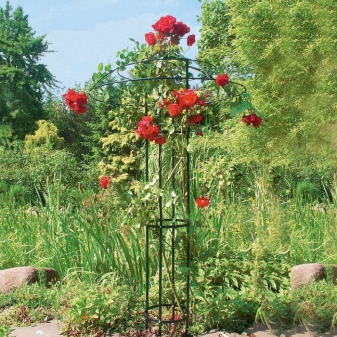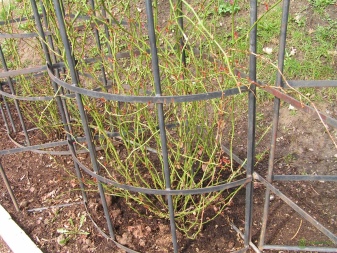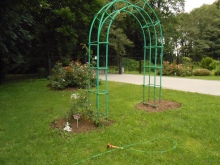Features of tapestries for roses and their application

Gardens differ from untouched nature for the better in that they have clear signs of human intervention and, thanks to it, have a more pronounced aesthetics. For crops growing by the will of the human breeder up to a height that cannot be sustained by their stems, trellises have been invented that significantly diversify the design of the infield.


Description and purpose
Rose trellis are vertical stands or frames that in many ways resemble supports for vineyards and other climbing plants. Thanks to this, you can experiment with the size of flowers in a flower bed - the height of a bush climbing or standard rose can significantly exceed human growth.
The potential use of such devices is quite obvious - they are necessary for a beautiful garden design and the creation of unusual floristic compositions. Thanks to the trellises, you can create a green wall that will allow you to build a summer gazebo without full-fledged partitions, but with an indescribable aroma. Depending on the specifics of a particular variety and the gardener's imagination, you can build tunnel paths or build impressive and romantic arches over the windows.
In addition to the purely aesthetic effect, trellises can still be vital for growing tall rose bushes. A plant with a thin and long stem cannot always support the weight of a huge bud, therefore, artificial support is simply indispensable.


Varieties
The easiest way to classify trellis for roses is by the shape that the support overgrown with greenery can create. In this sense, a huge number of varieties can be distinguished, because the best gardeners even build full-fledged pyramids and ladders, but most often one of three trellis options is found.
-
Arch. Traditional decoration of the entrance to anywhere. In the conditions of a personal plot, this can be an entrance to a residential building or a gazebo, and if zoning is provided in the garden, then to one of the zones. Trellis-arches, which are also often called pergolas, need attention to their stability, because the weight of the greenery can be very significant.


- Wall. Initially, it was customary to call wall-like structures trellis, but in recent years they are already considered only one of the trellis varieties. The wall-shaped trellis is the best suited for zoning the territory, since it significantly limits visibility and creates the feeling of being in a room, albeit in the open air. Depending on the purpose of the wall and the specifics of caring for a particular variety of roses, the buds can be directed in one direction or decorate the structure on both sides.


- Pillar. Such a solution in gardens is still used relatively rarely, and this is an important advantage if the gardener wants to make his site original and unique. Outside, the composition looks like a thick green pillar, but inside it is the main vertical support and several additional horizontal ones, made in the form of rings and located at different heights. Such a trellis can be located in the middle of a flower bed, making it seem to be three-dimensional, or installed near a bench. Single pillars can be used to furnish an entire path - then green wires can also be put on top of them.


Materials (edit)
Various materials are used for the production of trellises, but in the conditions of an ordinary summer cottage, which is decorated with the efforts of the owner himself, there will be only two options for raw materials from among those that can be easily handled.
Wood
Wooden trellises are first of all good because they are not a foreign body for the garden, because there is enough living wood here. The need for any kind of masking of the tree support simply does not arise, because it does not have to be shy - it looks harmoniously surrounded by flowers and even adds some coziness and naturalness to the trellis. Almost everyone has the necessary tool, you can assemble the frame with your own hands quickly and without special costs.
Significant disadvantages of wood are that it is not even close to being an eternal material. Under the influence of atmospheric moisture, it can rot, and any pests will be interested in such a biomaterial. Today, there are various impregnations, but they will have to be used regularly and quite often, and this is an additional expense of time and money.
For greater safety of the trellis, it is advisable to disassemble it and hide it indoors for the winter - otherwise it will not last long.


Metal
A metal trellis will last longer than a wooden one, because iron and steel are much stronger and more durable than wood. Remaining a natural material, the metal structure is no longer of interest to insects and fungi, and the only thing it is afraid of is moisture. However, this problem is easier to solve than in the case of wood - simply because the product will have to be painted no more often than once every few years. With a strong desire, the independent production of an iron trellis will not be difficult.
There are also disadvantages to the metal structure, but in this case there are already somewhat fewer of them. First of all, iron surrounded by greenery does not look as aesthetically pleasing as wood, but the issue is solved with the help of forged products with complex curls - they look elegant. True, it is unlikely that it will be possible to forge a lattice at home - you will have to contact a master and order production. A less pretentious trellis can be made independently, but then it will have to be carefully hidden behind green shoots. In addition, not everyone has the skills to work with metal, just as there is not a welding machine with a workshop in every home.


How to do it yourself?
To begin with, you should think about what kind of trellis you want to get at the output - what shape it will be, what sizes, where it is more correct to install it. It is advisable to consider several options, and not to grab the first one that comes to mind - this way the result will be better. At the next stage, it is necessary to draw up a drawing, on which it is imperative to indicate all the dimensions. All calculations should be pre-checked several times and only then start to work.
What are the advantages and disadvantages of different materials, we have already discussed above. In the conditions of your own site, it is logical to choose the raw materials that are available (will not require money for the purchase) and which you can personally process at home. It is more likely to be wood.
If there is neither one nor the other, make your own choice, given that you do not need a capital structure with a safety margin of several tons - ordinary reinforcement or timber will be enough.


Assembly is carried out in the most convenient way - wooden parts are most often connected with nails or similar fasteners, while metal is most reasonable to be welded. In this case, the impregnation of wood with protective compounds is carried out before the assembly, so that the protection penetrates even into future seams, but the painting of the iron structure is relevant already assembled.
Trellis are usually not so heavy that they have to be concreted - most often they only need to be dug into the ground to a sufficient depth. The sufficiency criterion strongly depends on the height of the product - the higher the trellis, and the greater its windage, the deeper it must be dug in, but the final position in any case must be reliable and stable. If a volumetric (not flat) arch is being constructed, which has more than two legs, it can not be dug in so deeply. Moreover, such a large-scale structure will be a priori heavier, because it is assembled after the first supports have been dug into the ground.


Growing roses on trellises
Please note that roses are not a classic climbing plant and will not cling to the trellis themselves - they must be tied up and periodically engaged in the formation of a bush, directing its growth in the right direction. Besides, in many varieties of roses, budding does not occur at the top of the stem, but on lateral branches located at right angles to the main stem. To make the flower look up, it is worth fixing the trunk of the bush in an approximately horizontal direction. At the same time, the binding should not interfere with normal growth - it only fixes the direction of the plant's development.
Wherein the primary should be the installation of the trellis, and not the cultivation of the plant. If there is already a bush on the site, during the installation of the supports, damage to the root system is possible - this can lead to unplanned death of the plant.
Pulling the bush too high is also not worth it - it will not bloom.



The following video will tell you how to make tapestries for roses with your own hands.


































































The comment was sent successfully.